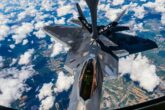
March 17, 2021
Trends, Timelines, and Uncertainty: An Assessment of the Military Balance in the Indo-Pacific
Testimony Before the Senate Foreign Relations Committee
Submitted Written Testimony
I. Introduction
Chairman Menendez, Ranking Member Risch, and members of the committee, thank you for the opportunity to share my thoughts on the military balance of power in the Indo-Pacific. It is a privilege to testify here on matters that are important to the vital national security interests of the United States, as well as those of our allies and partners in the region.
I will specifically address the ability of the United States—with our allies and partners—to deter military aggression by the People’s Republic of China (PRC) in the region, both now and in the future. I will then examine PRC and U.S. capabilities, points of vulnerability for China, and important points of uncertainty. Finally, I will offer recommendations about some of the steps that might be considered to improve and maintain deterrence, in the hopes of avoiding what would be, were it to occur, a catastrophic conflict for all concerned.
II. Status, Trends and Timelines in Regional Deterrence
When I consider the state of the military balance in the Indo-Pacific, my assessment is that we are entering a period of deep uncertainty. This is in stark contrast to the situation of perhaps twenty years ago, when I would have unhesitatingly predicted failure for the PRC in any attempt to engage in military aggression against our allies and partners in the region. It is also in contrast to the situation that, absent significant changes in current trends, we seem headed towards in ten to twenty more years’ time: PRC military domination of the region. Along these lines, though couched in somewhat more restrained language, the Air Force Chief of Staff and Marine Corps Commandant wrote just this week that, “Based on assessments conducted by senior military and civilian leaders over the past several years, to include multiple wargaming iterations, the prevailing wisdom is that the readiness and modernization trend lines indicate the joint force is not ready to satisfy the demands of great-power competition in the Indo-Pacific.”
That we could be headed toward that situation should be unsurprising given the larger strategic environment. With rough economic parity between the United States and China, over a longer timeline U.S. efforts to prevent Chinese military aggression or coercion in the region will run against a clear asymmetry of both geography and national will, given what the stakes mean to China. As such, efforts to deter China must be extraordinarily focused on the parts of the United States and our allies remain successful. To date, they have not been. Instead, some of the United States’ focus has been lost to distractions from Russia and the Middle East, while—for example—Taiwan’s focus has at times wandered to investments in conventional “status” weapon systems such as fighter aircraft and armored vehicles, instead of the capabilities genuinely needed to deter a Chinese invasion. While the United States and our allies have begun to recognize and take action to address the growing scale of the threat from China, these efforts continue to face institutional inertia as well as impediments from those who would be negatively affected by their implementation. As such, they have thus far been of somewhat limited impact in terms of their implementation.
The ongoing trends related to the regional military balance that concern me the most are not those directly tied to comparisons between, for example, Taiwan and Taiwan-adjacent forces of the People’s Liberation Army (PLA). Rather, I am most concerned about China’s development of broader regional capabilities which are clearly intended to counter or deter a U.S. intervention to defend our allies against Chinese aggression through the imposition of prohibitive costs, or the threat thereof. These are most visible in the form of China’s deployment of large numbers of capable precision-strike Intermediate Range Ballistic Missiles (IRBMs), its growing long-range bomber force, and its rapidly growing blue-water navy.
In my estimation the mid-to-late 2020s may be the period of greatest peril for a failure of deterrence in the region. This timeframe will see the trailing edge of a period of mass retirement of late-Cold War-era U.S. platforms, combined with the continued growth and modernization of China’s counter-intervention forces. In particular, the retirement of the Navy’s oldest cruisers, at nearly the same time as that of its four guided-missile submarines (SSGNs), will result in a significant drop in the available number of vertical-launch missile tubes that could be deployed in support of a regional contingency. This will occur before many of the most important China-focused changes implemented by the United States and its allies begin to bear fruit, but after sufficient time has elapsed for China to rectify some of its current capability gaps—for example, its capacity for sealift across the Taiwan Strait.
Download the full testimony.
More from CNAS
-
Are Defense Firms Showering Their Shareholders with Too Much Money?
In early January, President Donald Trump signed an executive order threatening bans on defense contractors paying dividends or buying their stock back. CNAS program director S...
By Stacie Pettyjohn
-
Defense & Aerospace Air Power Podcast: Global View
In a week when airpower news came from every angle, Becca Wasser, CNAS adjunct senior fellow, was on top of it all. She leads defense research at Bloomberg Economics, and we c...
By Becca Wasser
-
Balance of Power: Powell Probe Sparks GOP Backlash
President Donald Trump faced rare opposition from key Republican lawmakers after Federal Reserve Chair Jerome Powell accused the Department of Justice of launching a grand jur...
By Becca Wasser
-
The Venezuela Blockade
Roxanna Vigil, Council on Foreign Relations International Affairs Fellow, talks about President Donald Trump's order to blockade sanctioned oil tankers in Venezuela, and the r...
By Becca Wasser




